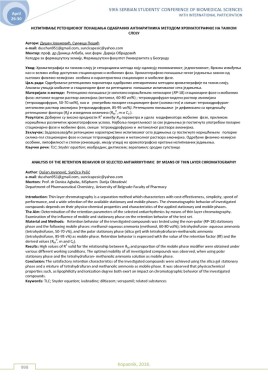Page 1004 - 59. КОНГРЕС СТУДЕНАТА БИОМЕДИЦИНСКИХ НАУКА СРБИЈЕ СА ИНТЕРНАЦИОНАЛНИМ УЧЕШЋЕМ
P. 1004
59th SERBIAN STUDENTS’ CONFERENCE OF BIOMEDICAL SCIENCES
April WITH INTERNATIONAL PARTICIPATION
26-30
ИСПИТИВАЊЕ РЕТЕНЦИОНОГ ПОНАШАЊА ОДАБРАНИХ АНТИАРИТМИКА МЕТОДОМ ХРОМАТОГРАФИЈЕ НА ТАНКОМ
СЛОЈУ
Аутори: Душан Јовановић, Сунчица Пешић
e-mail: duschan951@gmail.com, suncicapesic@yahoo.com
Ментор: проф. др Даница Агбаба, маг.фарм Дарија Обрадовић
Катедра за фармацеутску хемију, Фармацеутски факултет Универзитета у Београду
Увод: Хроматографија на танком слоју је сепарациона метода коју одликују економичност, једноставност, брзина извођења
као и велики избор доступних стационарних и мобилних фаза. Хроматографско понашање неког једињења зависи од
његових физичко-хемијских особина и карактеристика стационарне и мобилне фазе.
Циљ рада: Одређивање ретенционих параметара одабраних антиаритмика методом хроматографије на таком слоју.
Анализа утицаја мобилне и стационарне фазе на ретенционо понашање испитиваног сета једињења.
Материјали и методе: Ретенционо понашање је испитано коришћењем неполарне (RP-18) стационарне фазе и мобилних
фаза: метанол-водени раствор амонијака (метанол, 60-80 vol%) ; тетрахидрофуран-водени раствор амонијака
(тетрахидрофуран, 50-70 vol%), као и употребом поларне стационарне фазе (силика гел) и смеше: тетрахидрофуран-
метанолни раствор амонијака (тетрахидрофуран, 85-95 vol%). Ретенционо понашање је дефинисано са вредношћу
0
ретенционог фактора (R f ) и изведених величина (R M , m и C 0 ).
2
Резултати: Добијенe су високе вредности R између R M параметра и удела модификатора мобилне фазе, приликом
коришћења различитих хроматографских услова. Најбоља покретљивост за све једињења је постигнута употребом поларне
стационарне фазе и мобилне фазе, смеше тетрахидрофурана и метанолног раствора амонијака.
Закључак: Задовољавајуће ретенционе карактеристике испитиваног сета једињења су постигнуте коришћењем поларне
силика-гел стационарне фазе и смеше тетрахидрофурана и метанолног раствора амонијака. Одређене физичко-хемијске
особине, липофилност и степен јонизације, имају утицај на хроматографско кретање испитиваних једињења.
Кључне речи: TLC; Snyder equation; ивабрадин; дилтиазем; верапамил; сродне супстанце
ANALYSIS OF THE RETENTION BEHAVIOR OF SELECTED ANTIARRHYTHMIC BY MEANS OF THIN LAYER CHROMATOGRAPHY
Аuthor: Dušan Jovanović, Sunčica Pešić
e-mail: duschan951@gmail.com, suncicapesic@yahoo.com
Mentors: Prof. dr Danica Agbaba, MSpharm Darija Obradović
Department of Pharmaceutical Chemistry, University of Belgrade-Faculty of Pharmacy
Introduction: Thin layer chromatography is a separation method which characterizes with cost-effectiveness, simplicity, speed of
performance, and a wide selection of the available stationary and mobile phases. The chromatographic behavior of investigated
compounds depends on their physico-chemical properties and characteristics of the applied stationary and mobile phases.
The Aim: Determination of the retention parameters of the selected antiarrhythmics by means of thin layer chromatography.
Examination of the influence of mobile and stationary phase on the retention behavior of the test set.
Material and Methods: Retention behavior of the investigated compounds was tested using the non-polar (RP-18) stationary
phase and the following mobile phases: methanol-aqueous ammonia (methanol, 60-80 vol%); tetrahydrofuran- aqueous ammonia
(tetrahydrofuran, 50-70 v%), and the polar stationary phase (silica gel) with tetrahydrofuran-methanolic ammonia
(tetrahydrofuran, 85-95 v%) as mobile phase. Retention behavior is expressed with the value of the retention factor (Rf) and the
0
derived values (R M , m and C 0 ).
2
Results: High values of R valid for the relationship between R M and proportion of the mobile phase modifier were obtained under
various different working conditions. The optimal mobility of all investigated compounds was observed, when using polar
stationary phase and the tetrahydrofuran- methanolic ammonia solution as mobile phase.
Conclusion: The satisfactory retention characteristics of the investigated compounds were achieved using the silica gel stationary
phase and a mixture of tetrahydrofuran and methanolic ammonia as mobile phase. It was observed that physicochemical
properties such, as lipophilicity and ionization degree both exert an impact on chromatographic behavior of the investigated
compounds.
Keywords: TLC; Snyder equation; ivabradine; diltiazem; verapamil; related substances
Kopaonik, 2018.
998

